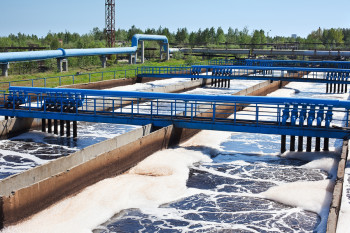
Wastewater treatment plant.
There’s a new system out there that promises to remove ammonia from wastewater, to create clean water and to generate electricity – all at the same time.
If that wasn’t enough, it is also green. The key to this wastewater rejuvenation system is that it uses bacterial batteries.
By combining a microbial electrochemical cell and a forward osmosis cell, the engineers at Virginia Tech created a hybrid biological and electrochemical system. The microbial electrochemical cell allows bacteria to conduct electron-shuttling chemical reactions, while the forward osmosis cell uses a highly concentrated mixture to pull clean water through a membrane to remove impurities. Electricity produced by the electrochemical cell can also be stored in a battery or passed to the grid.
Similar to other electrochemical cells, the circuit is completed as ions (in this case ammonium) are pushed to the other side of the cell. This process will produce an ammonium-rich solution.

Ammonia molecule, NH3
Other wastewater treatment plants will produce biogas which can be used to create electricity. Unfortunately, the generators used to create electricity from biogas can be expensive and hard to maintain. This system from Virginia Tech, however, promises to rule out the need for storing and burning biogas.
The system caters to the current demand for ammonia-based fertilizer. The demand is so high in fact, that one percent of the world’s electricity goes to the process that produces ammonia from nitrogen gas.
Although the amount of ammonia taken from wastewater processes won’t be enough to disregard ammonia synthesis from nitrogen completely, it provides a more sustainable method to acquire ammonia, to generate electricity and to protect aquatic ecosystems from algae blooms.
The system was created by Mohan Qin, who is a second-year doctoral student at the Virginia Tech College of Engineering. Qin was awarded the 2015 Innovation Award for Best Technological Advancement from the International Society for Microbial Electrochemistry and Technology for her work. To learn more about innovative research projects being conducted at the Virginia Tech College of Engineering, go to their website.
Do you think farmers will be able to one day produce their own power, clean water and ammonia based fertilizer using this method? Or are there other green technologies, like biodiesel, that you think will win out? Comment below.